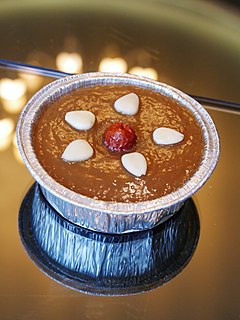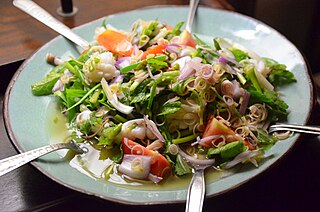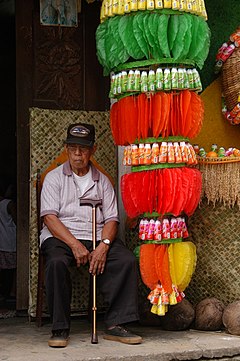
Thai cuisine is the national cuisine of Thailand.

Glutinous rice is a type of rice grown mainly in Southeast and East Asia, and the northeastern regions of South Asia, which has opaque grains, very low amylose content, and is especially sticky when cooked. It is widely consumed across Asia.
Malaysian cuisine consists of cooking traditions and practices found in Malaysia, and reflects the multi-ethnic makeup of its population. The vast majority of Malaysia's population can roughly be divided among three major ethnic groups: Malays, Chinese and Indians. The remainder consists of the indigenous peoples of Sabah and Sarawak in East Malaysia, the Orang Asli of Peninsular Malaysia, the Peranakan and Eurasian creole communities, as well as a significant number of foreign workers and expatriates.

Malay cuisine is the traditional food of the ethnic Malays of Southeast Asia, residing in modern-day Malaysia, Indonesia, Singapore, Brunei, Southern Thailand and the Philippines as well as Cocos Islands, Christmas Island, Sri Lanka and South Africa.

Kuih are bite-sized snack or dessert foods commonly found in Southeast Asia and China. It is a fairly broad term which may include items that would be called cakes, cookies, dumplings, pudding, biscuits, or pastries in English and are usually made from rice or glutinous rice. In China, where the term originates from, kueh or koé in the Min Nan languages refers to snacks which are typically made from rice but can occasionally be made from other grains such as wheat. The term kuih is widely used in Malaysia, Brunei, and Singapore, kueh is used in Singapore and Indonesia, kue is used in Indonesia only, all three refer to sweet or savoury desserts.

Filipino cuisine is composed of the cuisines of more than a hundred distinct ethnolinguistic groups found throughout the Philippine archipelago. A majority of mainstream Filipino dishes that compose Filipino cuisine are from the food traditions of various ethnolinguistic groups and tribes of the archipelago, including the Ilocano, Pangasinan, Kapampangan, Tagalog, Bicolano, Visayan, Chavacano and Maranao ethnolinguistic groups. The style of food making and preparation, and the dishes associated with them, have evolved over many centuries from a largely indigenous base shared with maritime Southeast Asia with varied influences from Chinese, Spanish and American cuisines, in line with the major waves of influence that had enriched the cultures of the archipelago, as well as others adapted to indigenous ingredients and the local palate.

Nian gao, sometimes translated as year cake or New Year cake or Chinese New Year's cake, is a food prepared from glutinous rice flour and consumed in Chinese cuisine. It is also simply known as "rice cake". While it can be eaten all year round, traditionally it is most popular during the Chinese New Year. It is considered good luck to eat nian gao during this time of the year because nian gao (年糕) is a homonym for "higher year" or "grow every year" (年高), which means "a more prosperous year". The character 年 is literally translated as "year", and the character 糕 (gāo) is literally translated as "cake" and is identical in sound to the character 高, meaning "tall" or "high". Nian gao (年糕) also has the exact homonym for "sticky cake" (粘糕); the character 粘 (nián), meaning "sticky".

The generic term for condiments in the Filipino cuisine is sawsawan. Unlike sauces in other Southeast Asian regions, most sawsawan are not prepared beforehand, but are assembled on the table according to the preferences of the diner.

A rice cake may be any kind of food item made from rice that has been shaped, condensed, or otherwise combined into a single object. A wide variety of rice cakes exist in many different cultures in which rice is eaten and are particularly prevalent in Asia. Common variations include cakes made with rice flour, those made from ground rice, and those made from whole grains of rice compressed together or combined with some other binding substance.

Tangyuan is a traditional Chinese dessert made of glutinous rice shaped into a ball that is served in a hot broth or syrup. They come in varying sizes, anything between a marble to a ping pong ball, and are sometimes stuffed with filling. Tangyuan is traditionally eaten during the Lantern Festival, but because its name is a homophone for union and symbolizes togetherness and completeness, this dish is also served at weddings, family reunions, Chinese New Year, and the Dōngzhì festival.

Kue is an Indonesian bite-sized snack or dessert food. Kue is a fairly broad term in Indonesian to describe a wide variety of snacks including cakes, cookies, fritters, pies, scones, and patisserie. Kue are made from a variety of ingredients in various forms; some are steamed, fried or baked. Kue are popular snacks in Indonesia, which has the largest variety of kue. Because of the countries' historical colonial ties, Koeé (kue) is also popular in the Netherlands.

Javanese cuisine is the cuisine of Javanese people, a major ethnic group in Indonesia, more precisely the province of Central Java, Yogyakarta and East Java.

Quezon, officially the Province of Quezon, is a province in the Philippines located in the Calabarzon region on Luzon. Kalilayan was the first known name of the province. It was later renamed Tayabas. In honor of the former governor of the province who later became the second president of the Philippines and the first to be freely elected, Manuel L. Quezon, the province’s name was then changed to Quezon. Lucena, the provincial capital, seat of the provincial government, and the most populous city of the province, is governed independently from the province as a highly urbanized city. To distinguish the province from Quezon City, it is sometimes called Quezon Province.

Sundanese cuisine is the cuisine of the Sundanese people of Western Java, and Banten, Indonesia. It is one of the most popular foods in Indonesia. Sundanese food is characterised by its freshness; the famous lalab eaten with sambal and also karedok demonstrate the Sundanese fondness for fresh raw vegetables. Unlike the rich and spicy taste, infused with coconut milk and curry of Minangkabau cuisine, the Sundanese cuisine displays the simple and clear taste; ranged from savoury salty, fresh sourness, mild sweetness, to hot and spicy.

Nam chim or nam jim is Thai for "dipping sauce". It can refer to a wide variety of dipping sauces in Thai cuisine, with many of them a combination of salty, sweet, spicy and sour.

Salads that are internationally known as Thai salads, with a few exceptions, fall into four main methods of preparation. In Thai cuisine these are called yam, tam, lap and phla. A few additional dishes can also be regarded as being a salad.

Bánh tét is a Vietnamese savoury but sometimes sweetened cake made primarily from glutinous rice, which is rolled in a banana leaf into a thick, log-like cylindrical shape, with a mung bean or mung bean and pork filling, then boiled. After cooking, the banana leaf is removed and the cake is sliced into wheel-shaped servings.
Kabkab, also known as cassava cracker or cassava crisp, is a traditional Filipino disc-shaped wafer made from ground cassava. It originates from the southern Philippines, but is most closely associated with the cuisine of Mindanao and the southern Visayas Islands.



















